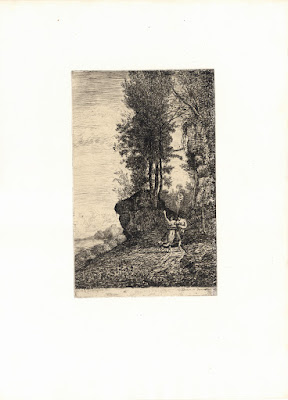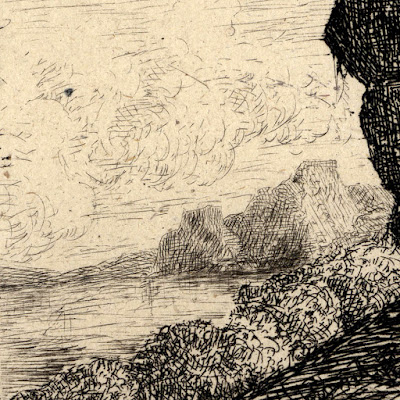Xavier
de Dananche (1828–94)
“Paysage Antique”, c.1870, most likely published by Cadart (see
note below) for the Société des Aquafortistes and printed by Auguste
Delâtre (1822–1907). Note: my proposal of who published and printed this
etching is based on the artist’s usual practice and his membership with the
Société des Aquafortistes.
Etching on cream chine collé with full margins as published
(presumably by either Cadart & Luquet or more likely Cadart & Luce as
the partnership between Alfred Cadart and Jules Luquet ended in 1867 and Luquet
was replaced with Léandre Luce c.1870)
Size: (sheet) 35.5 x 25.6 cm; (plate) 20 x 12.6 cm
Lettered below the image borderline at (left) “XAVIER DANA … [“N”
in reverse]CHE SC.”; (partly erased and very faint at centre) “PAYSAGE ANTIQUE”;
(right in script) “Xavier de Dananche”
Condition: richly inked impression in near faultless condition
with generous margins.
I am selling this very poetic and beautiful etching by a pupil of the
legendary Corot for AU$182 (currently US$125.22/EUR112.36/GBP99.02 at the time of
this listing) including postage and handling to anywhere in the world.
If you are interested in purchasing this print inspired by a
classical past, please contact me (oz_jim@printsandprinciples.com) and I will
send you a PayPal invoice to make the payment easy.
Although this etching leans heavily towards the classical tradition
with regard to the portrayed pair of figures in the foreground presented as
bare breasted followed in the distance by what I assume to be a satyr (also bare
breasted), the free handling of the drawing is far from academic. Indeed, I see
much more of Corot— Xavier de Dananche’s distinguished
teacher—in the breadth of the approach used to draw the scene.
What I mean here by “breadth” is the way that the artist has
captured an overall effect of what can be seen rather than representing each
landscape feature as being visually distinct and separate to the next. In short,
I have a strong suspicion that this etching was inscribed on the plate out-of-doors
rather than in the studio in accordance with Corot’s approach of direct
observation when creating an image.
Not all of the line-work shown in this print, however, is stylistically
well-integrated and it is certainly not as integrated as may be seen in Corot
drawings or one of his rare etchings or cliché verre prints (see for example
the superb cliché verre by Corot that I have listed earlier: http://www.printsandprinciples.com/2017/01/corots-cliche-verre-print-little-sister.html).
For instance, I see the very close attention to detail shown in the rendering
of the far distant trees as being quite different in mindset to the hand that
executed the rest of the composition—a case of stylistic inconsistency where I
wouldn’t be surprised to learn that the distant features in the print were
drawn in the studio.
This print has been sold






No comments:
Post a Comment
Please let me know your thoughts, advice about inaccuracies (including typos) and additional information that you would like to add to any post.